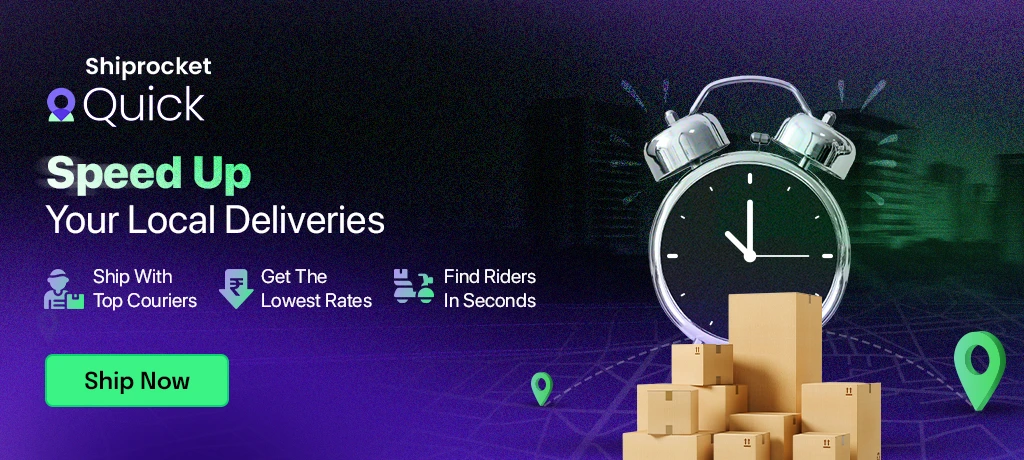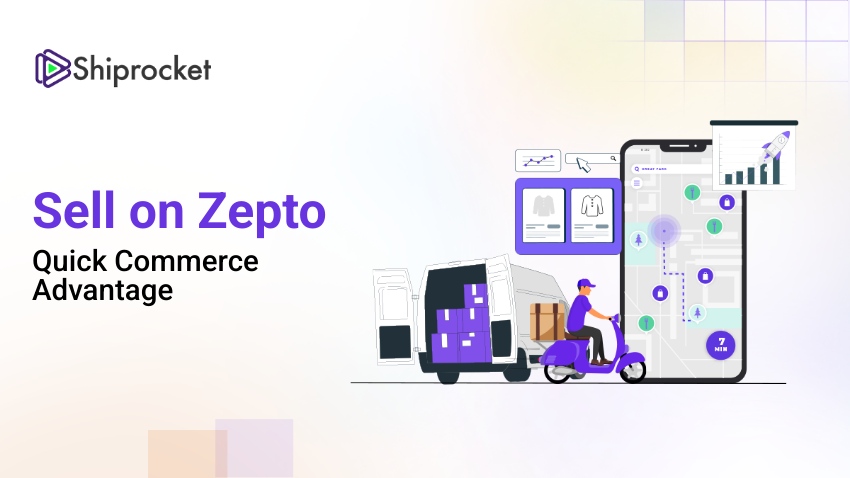Meat Delivery Apps in India: Top Players, Features, and How to Build Your Own
- Top Meat Delivery Apps in India
- Leading Meat Delivery Apps Outside India
- Key Functionalities Every Chicken Delivery App Must Offer
- Step-by-Step Guide to Building Your Meat Delivery App
- Cost Breakdown for Developing an Online Meat Delivery App
- What About Deliveries? Power Your App with Shiprocket Quick
- Conclusion
Many people want fresh chicken, steak, or other meats without the hassle of going to the store. Online meat delivery apps have made this possible by bringing a variety of meat products right to the customer’s doorstep. These apps have gained popularity as they save time and offer convenience, particularly for busy households.
By 2025, it is estimated that the online grocery delivery market in India will reach a revenue of USD 40.06 billion. Several top apps have established themselves by offering high-quality options, quick delivery, and convenient payment methods. They focus on providing fresh and hygienic products while delivering a satisfactory experience.
This trend not only benefits customers but also creates opportunities for new businesses wanting to join this growing market. This blog will explore the best meat delivery apps available and examine the features that make them stand out. You will also know what it takes to build a successful delivery app to enter this field.
Top Meat Delivery Apps in India
Below is an overview of some of the most popular platforms for meat delivery you should be aware of.
Fresh To Home
Fresh To Home was launched in 2015 and then expanded its services beyond India, reaching the UAE market. It serves 27 cities in India and has crossed five million downloads on Google Play. This app offers chicken, meat, seafood, and even fruits and vegetables that are free from antibiotics and added chemicals. It appeals to health-conscious consumers by promoting chemical-free, fresh produce.
Fipola
Fipola is a fast-growing meat delivery company based in Chennai, with operations active in cities such as Bengaluru, Hyderabad, and Coimbatore. It offers a wide variety of items, including fresh chicken, seafood, ready-to-cook products, cold cuts, eggs, and even vegan meat. Its meat is Halal-certified, free from chemicals, and handled using cold chain systems for maximum freshness.
Licious
Licious stands as one of India’s earliest online meat and seafood delivery platforms, which was started in 2015. It quickly grew to cover over 28 cities and earned more than 10 million downloads. The app attracts Indian buyers who want premium meat and seafood delivered fast, often within two hours. The company’s ability to handle fresh inventory efficiently and maintain hygiene standards has helped it grow.
Meatigo
Meatigo is a premium meat delivery platform that focuses on quality, hygiene, and variety. It offers everything from cold cuts and ready-to-cook meals to exotic meats, sourced from government-approved suppliers. Operating in cities like Delhi NCR, Mumbai, Bengaluru, Pune, Hyderabad, and Kolkata, Meatigo has carved a niche among customers who prefer restaurant-grade meat at home.
TenderCuts
TenderCuts delivers fresh, antibiotic-free meat and seafood, sourced daily and processed in hygienic facilities. With a wide selection including mutton, poultry, fish, and marinades, it serves cities such as Chennai, Hyderabad, Bengaluru, Coimbatore, and Vijayawada. The app’s mix of convenience, freshness, and ready-to-cook options has made it a go-to for busy urban households.
MeatOnn
Based out of Hyderabad, MeatOnn specializes in delivering fresh, Halal-certified chicken, mutton, fish, and eggs. With a focus on quality control, cold-chain logistics, and fast deliveries, the brand is expanding its presence in and around Hyderabad. Its simple interface and commitment to freshness have helped it build a loyal customer base.
Good Meat Company
The Good Meat Company promotes ethically sourced and preservative-free meat products, including fresh chicken, mutton, seafood, and value-added items like kebabs and curries. Currently operational in Bengaluru and steadily expanding, the brand is known for combining modern cold-chain practices with a strong emphasis on food safety and taste.
Leading Meat Delivery Apps Outside India
Globally, meat delivery platforms are innovating with subscription models, ethical sourcing, and gourmet offerings. These international players are redefining how customers shop for high-quality meat.
ButcherBox
ButcherBox began as a subscription-only service specialising in premium, humanely raised meats and responsibly sourced seafood. Over time, it shifted to a non-subscription model to expand reach. Though exact download numbers aren’t public, the company has achieved stability by emphasising ethical sourcing and high-quality products.
Crowd Cow
Crowd Cow, based in Seattle and founded in 2015, presents a unique approach by allowing customers to share ownership of cows and purchase meat portions. This appeals to buyers who value ethical treatment of animals and transparency in sourcing. Although download data is limited, it still stands out for its innovative concept and loyal user base.
Wild Fork Foods
Wild Fork Foods aims to create a modern meat shopping experience, offering frozen seafood and meat at budget-friendly prices. The app version on Aptoide has garnered over 1,000 downloads, and a new version was released in August 2024. The focus is on frozen items, which expands shelf life and makes logistics easier.
D’Artagnan Foods
It was founded in 1985 and has a long history, selling gourmet meats such as Wagyu beef, game meats, and foie gras. Mostly focused on business-to-business sales, it also offers online shopping for restaurants and retailers. Its success shows how suppliers can work closely with foodservice businesses and upscale markets.
Meat N Bone
Meat N Bone specialises in gourmet products and delivers to customers seeking high-end meat cuts. It specialises in premium meats like Iberico pork, game meats, and Wagyu beef. This model suggests that exclusive offerings can be effective when paired with strong branding and a positive customer experience.
Key Functionalities Every Chicken Delivery App Must Offer
Here are some essential features that your chicken delivery app should have to meet the expectations of modern buyers.
Easy-to-Use Interface
The app should be simple and clear for users to browse through products quickly. Clean design and easy navigation help customers find what they want without confusion. Using categories, large product photos, and menus can improve the buying experience. A smooth interface encourages buyers to spend more time on the app, increasing the chances of orders.
Search and Filters
Customers want to find products quickly. Including a search bar with filters for features such as cut type, price, weight, and preparation style can make the selection process easier. These filters help narrow down choices based on specific needs. This also reduces the chances of users abandoning the app due to frustration.
Wide Variety
Ensure the app offers a range of options to attract a large customer base and cater to diverse tastes. This includes different types, such as organic, free-range, or regular chicken. Additionally, various cuts, such as whole chicken, breasts, thighs, wings, and drumsticks, should be available. Offering both raw and marinated choices caters to different cooking preferences.
Detailed Information
Each chicken item should be accompanied by a thorough description. Information such as where the chicken comes from, how it was processed, and its nutritional facts helps users feel confident about their purchase. Providing clear and honest details demonstrates transparency, which fosters trust and encourages repeat business.
Safe Payment Options
Offering multiple payment methods ensures that users can complete their purchase without hassle. Secure gateways for UPI, debit and credit cards, as well as popular digital wallets, are essential. The app should ensure that payment data is protected, making customers feel secure when making online payments.
Live Order Tracking
Tracking orders in real-time is becoming standard. Users expect to see where their delivery is from the moment they place the order until it reaches their door. This feature improves clarity and informs buyers about the order.
Customer Support
Good customer support is essential to handle any questions or problems. Providing chat, phone, or email support within the app enhances the shopping experience. Prompt issue resolution keeps shoppers satisfied and reduces negative feedback.
Step-by-Step Guide to Building Your Meat Delivery App
If you’re intending to launch meat delivery apps, you need a plan that covers every stage of app development. This guide will discuss the complete process of creating an app for your business.
- Step 1: Define Your Niche
Start by deciding on the specific market your app will target. Choose what types of meat you want to offer, whether special cuts, marinated options, or local favourites. Defining this early helps set a clear identity for your app. Next, list all essential features of your ads.
These might include browsing a product catalogue, filtering search results, adding items to a cart, secure payment options, order tracking, and delivery scheduling. The clearer your requirements, the easier it will be for developers to build an app that matches your business goals.
- Step 2: Choose the Right Partner
Selecting an experienced development company is key. Look for teams that have built similar food delivery or grocery apps before. Review their portfolio and read their reviews to determine if their work aligns with your expectations. They must understand the challenges in food delivery, such as handling perishable goods and managing cold storage logistics.
Additionally, confirm their skills across various platforms, including iOS and Android, as well as backend technologies. Communication is crucial during the project, so choose a partner who keeps you informed and respects your deadlines and budget.
- Step 3: Design and Development
This phase shapes how your app looks and works. The design team should create a simple and visually appealing user interface that aligns with your brand image. The app must be easy to use, since customers may order from mobile devices on the go.
Once the design is ready, developers build the app by working on the front-end (what users see), back-end (server and database management), and APIs (which allow the app to send and receive data). Regular communication with the development team helps avoid misunderstandings and ensures the final product meets your standards.
- Step 4: Testing and Quality Checks
Before going live, your app must go through several testing stages. Tests should include checking each feature separately, ensuring different sections work well together, and seeing how the app performs. Fix all bugs, improve load time, and verify that all payment and delivery processes are functioning as intended.
Testing with actual users can help identify issues that might otherwise be overlooked. Skipping thorough testing can cause problems after launch, so allocate enough time to ensure the app runs smoothly and offers a good user experience.
- Step 5: Launch and Ongoing Support
Once testing is complete and you approve the app, it’s time to launch it on app stores like Google Play and Apple’s App Store. Your development partner should assist with this process, including promoting your app so it gets noticed by potential users.
Even after launch, you’ll need regular updates, bug fixes, and customer feedback handling to keep your app functioning properly. You’ll need a team that offers post-launch support and helps with technical improvements based on real experience.
Cost Breakdown for Developing an Online Meat Delivery App
Developing meat delivery apps in India involves several cost factors that you should keep in mind. The total expense can range from ₹12 lakhs to ₹40 lakhs, depending on various factors. Here’s how the overall cost is split across different areas.
App Feature Complexity
The more advanced the app features, the higher the development cost. Basic functions, such as browsing meat products and placing orders cost less, typically between ₹2–4 lakhs. Adding options such as live order tracking, multiple payment methods, or vendor dashboards can increase costs significantly, pushing the budget to ₹8–12 lakhs or more. You must decide which features are essential to attract and retain customers while balancing costs.
Platform Choice
Creating an app for a single platform, such as Android or iOS, is generally cheaper than building for both which costs around ₹3–5 lakhs for one, versus ₹6–10 lakhs for both. Cross-platform apps can save money early on, but they may have performance limitations. Native apps tailored for each platform typically cost more but offer a smoother experience. When choosing platforms, weigh initial expenses against long-term benefits.
UI/UX Design
A basic layout may cost less, in the range of ₹1–2 lakhs, but it won’t stand out. If you want clean visuals, simple flows, and good animations, you’ll need to invest more in design which means ₹3–5 lakhs or higher. The better the design, the easier it is for buyers to place orders, which ultimately benefits you, but increases your upfront costs.
Backend Development
The backend handles server-side processes, databases, business rules, and APIs that connect different parts of the app. Depending on the complexity, backend work may cost ₹5–10 lakhs or more. If the app needs to support multiple users, handle sensitive data securely, or scale up quickly, the backend work will be more expensive.
Third-Party Integrations
Adding services such as payment gateways, map tools for delivery tracking, and notification systems requires additional development time. These integrations can cost an additional ₹1–3 lakhs. They add convenience but increase the overall cost of the app.
Team’s Location and Expertise
Teams in the US or Western Europe charge significantly more per hour compared to those in South Asia or Eastern Europe. In India, you can expect skilled app development teams to charge ₹800–₹2,500 per hour. Experience also affects price as experts charge more, but they usually work faster and need fewer revisions. You can reduce expenses by working with teams in cost-effective locations, but ensure quality is not compromised.
Testing and Quality Assurance
Thorough testing on various devices and scenarios assures the app runs smoothly without bugs. This phase can add ₹1–2 lakhs to your budget. You must invest in quality assurance to avoid future problems and protect your brand reputation.
What About Deliveries? Power Your App with Shiprocket Quick
Now that you’re set to build your meat delivery app, the next big question is — how will you fulfill orders quickly and reliably? That’s where Shiprocket Quick comes in.
Speed is everything in hyperlocal delivery, and Shiprocket Quick ensures your products reach customers on the same day or the next. By integrating your store or app with our logistics system, you get real-time inventory tracking, automated order processing, and seamless dispatch — all without manual intervention.
Our smart fulfillment network stores your products closer to your buyers, reducing delivery time and costs. You only pay for the space you use, making it ideal even for growing businesses.
From live shipment tracking to returns handling, and from B2C to B2B deliveries, Shiprocket Quick offers the full stack. Our tech-driven dashboard helps you manage stock, orders, and multi-channel sales — so you can scale operations without building warehouses or worrying about logistics.
Deliver faster. Grow quicker. Choose Shiprocket Quick.
Conclusion
Leading meat delivery apps have shown how simple and smooth online meat shopping can be. Their success demonstrates that customers appreciate the convenience of ordering fresh meat with just a few clicks. Inspired by these platforms, many butchers, suppliers, and processors now see the value in moving their business online.
They want to expand their reach beyond their local shops and increase their profits. If you run a meat business, creating your own branded delivery app can help you connect with more buyers and grow your income. The shift to online meat shopping makes ordering faster and more convenient for everyone involved.






